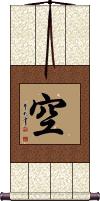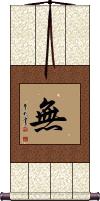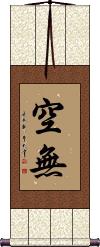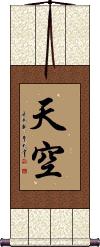Many custom options...
And formats...

Nothingness in Chinese / Japanese...
Buy a Nothingness calligraphy wall scroll here!
Personalize your custom “Nothingness” project by clicking the button next to your favorite “Nothingness” title below...
Sky / Ether / Void / Emptiness / Unreality
(Used in Japanese version of five elements)
空 is a single character that means empty, void, hollow, vacant, vacuum, blank, nonexistent, vacuity, voidness, emptiness, non-existence, immateriality, unreality, the false or illusory nature of all existence, and being unreal.
In the Buddhist context, this relates to the doctrine that all phenomena and the ego have no reality but are composed of a certain number of skandhas or elements, which disintegrate. The void, the sky, space. The universal, the absolute, complete abstraction without relativity. The doctrine further explains that all things are compounds, or unstable organisms, possessing no self-essence, i.e. are dependent, or caused, come into existence only to perish. The underlying reality, the principle of eternal relativity, or non-infinity, i.e. śūnya, permeates all phenomena making possible their evolution.
From Sanskrit and/or Pali, this is the translation to Chinese and Japanese of the title śūnya or śūnyatā.
In Japanese, when pronounced as “ron” (sounds like “roan”) this can be a given name. It should be noted that this Kanji has about 5 different possible pronunciations in Japanese: kuu, kara, sora, ron, and uro. 空 is also an element in the Japanese version of the five elements.
Nothing / Nothingness
無 is the simple way to express “nothing.”
However, this single character leaves a bit of mystery as to what you might really mean if you hang it as a wall scroll. I'm not saying that's a bad thing; as you can decide what it means to you, and you won't be wrong if you stay within the general context.
More info: 無 is usually used as a suffix or prefix for Chinese and Japanese words (also old Korean). It can be compared to “un-” or “-less” in English. It can also mean “not to have,” no, none, not, “to lack,” or nothingness.
Nothingness / Empty / Void
虛空 means empty space, empty sky, or void.
In the Buddhist context, it can mean “emptiness of the material world.” This can also be used as an adjective to modify other words with a meaning of unreal or insubstantial.
Nothingness
空無 is “nothingness” in a Buddhist context.
The first character means empty but can also mean air or sky (air and sky have no form).
The second character means have not, no, none, not, or to lack.
Together these characters reinforce each other into a word that means “absolute nothingness.”
I know this is a term used in Buddhism, but I have not yet figured out the context in which it is used. I suppose it can be the fact that Buddhists believe that the world is a non-real illusion, or perhaps it's about visualizing yourself as “nothing” and therefore leaving behind your desire and worldliness.
Buddhist concepts and titles often have this element of ambiguity or, rather, “mystery.” Therefore, such ideas can have different meanings to different people, and that's okay. If you don't get it right in this lifetime, there will be plenty more lifetimes to master it (whatever “it” is, and if “it” really exists at all).
Soothill defines this as “Unreality, or immateriality, of things, which is defined as nothing existing of independent or self-contained nature.”
Sky / Air / Ether / Space
These search terms might be related to Nothingness:
Better to Choose Nothing, Rather Than Make a Poor Choice
Fear No Man / Fear Nothing
Nothing / Nothingness
Nothing is Impossible
Nothing is Impossible With Persistence
Nothingness / Empty / Void
Sky / Ether / Void / Emptiness / Unreality
Sky / Void
The Destination is Nothing Without the Journey
True Emptiness Yields Transcendent Existence
Not the results for nothingness that you were looking for?
Below are some entries from our dictionary that may match your nothingness search...
| Characters If shown, 2nd row is Simp. Chinese |
Pronunciation Romanization |
Simple Dictionary Definition |
如 see styles |
rú ru2 ju nyo にょ |
as; as if; such as {Buddh} (See 真如) tathata (the ultimate nature of all things); (female given name) Yuki tathā 多陀; 但他 (or 怛他), so, thus, in such manner, like, as. It is used in the sense of the absolute, the 空 śūnya, which is 諸佛之實相 the reality of all Buddhas; hence 如 ru is 賃相 the undifferentiated whole of things, the ultimate reality; it is 諸法之性 the nature of all things, hence it connotes 法性 faxing which is 眞實之際極 the ultimate of reality, or the absolute, and therefore connotes 實際 ultimate reality. The ultimate nature of all things being 如 ru, the one undivided same, it also connotes 理 li, the principle or theory behind all things, and this 理 li universal law, being the 眞實 truth or ultimate reality; 如 ru is termed 眞如 bhūtatathatā, the real so, or suchness, or reality, the ultimate or the all, i. e. the 一如 yiru. In regard to 如 ju as 理 li the Prajñā-pāramitā puṇḍarīka makes it the 中 zhong, neither matter nor nothingness. It is also used in the ordinary sense of so, like, as (cf yathā). |
九地 see styles |
jiǔ dì jiu3 di4 chiu ti kyuuchi / kyuchi きゅうち |
very low land; (surname) Kuji The nine lands, i.e. the 欲界 realm of desire or sensuous realm the four 色界 realms of form or material forms; and the four 無色界 formless realms, or realms beyond form; v. 九有, 九有情居, 禪 and 定. The nine realms are:—(1) 欲界五趣地; the desire realm with its five gati, i.e. hells, hungry ghosts, animals, men, and devas. In the four form-realms are:— (2) 離生喜樂地 Paradise after earthly life, this is also the first dhyāna, or subject of meditation, 初禪. (3) 定生喜樂地 Paradise of cessation of rebirth, 二禪. (4) 離喜妙樂地 Land of wondrous joy after the previous joys, 三禪. (5) 捨念淸淨地 The Pure Land of abandonment of thought, or recollection (of past delights), 四禪. The four formless, or infinite realms, catur arūpa dhātu, are:—(6) 空無邊處地 ākāśānantyā-yatanam, the land of infinite space; also the first samādhi, 第一定. (7) 識無邊處地 vijñānānamtyāyatanam, the land of omniscience, or infinite perception, 二定. (8) 無所有處地 ākiñcanyāyatana, the land of nothingness, 三定. (9) 非想非非想處地 naivasaṁjñānā-saṁjñāyatana, the land (of knowledge) without thinking or not thinking, or where there is neither consciousness nor unconsciousness, i.e. above either; this is the 四定. Eitel says that in the last four, "Life lasts 20,000 great kalpas in the 1st, 40,000 in the 2nd, 60,000 in the 3rd, and 80,000 great kalpas in the 4th of these heavens." |
四劫 see styles |
sì jié si4 jie2 ssu chieh shikou / shiko しこう |
{Buddh} (See 劫・1) the four kalpa (formation, existence, destruction, nothingness) The four kalpas, or epochs, of a world, 成劫 that of formation and completion; 住劫 existing or abiding; 懷劫 destruction; and 空劫 annihilation, or the succeeding void. 倶舍論 12. |
成空 see styles |
seikuu / seku せいくう |
come to nothingness |
法性 see styles |
fǎ xìng fa3 xing4 fa hsing hosshou; houshou / hossho; hosho ほっしょう; ほうしょう |
{Buddh} (See 法相・ほっそう・1) dharmata (dharma nature, the true nature of all manifest phenomena); (personal name) Hosshou dharmatā. Dharma-nature, the nature underlying all thing, the bhūtatathatā, a Mahāyāna philosophical concept unknown in Hīnayāna, v. 眞如 and its various definitions in the 法相, 三論 (or法性), 華嚴, and 天台 Schools. It is discussed both in its absolute and relative senses, or static and dynamic. In the Mahāparinirvāṇa sūtra and various śāstras the term has numerous alternative forms, which may be taken as definitions, i. e. 法定 inherent dharma, or Buddha-nature; 法住 abiding dharma-nature; 法界 dharmakṣetra, realm of dharma; 法身 dharmakāya, embodiment of dharma; 實際 region of reality; 實相 reality; 空性 nature of the Void, i. e. immaterial nature; 佛性 Buddha-nature; 無相 appearance of nothingness, or immateriality; 眞如 bhūtatathatā; 如來藏 tathāgatagarbha; 平等性 universal nature; 離生性 immortal nature; 無我性 impersonal nature; 虛定界: realm of abstraction; 不虛妄性 nature of no illusion; 不變異性 immutable nature; 不思議界 realm beyond thought; 自性淸淨心 mind of absolute purity, or unsulliedness, etc. Of these the terms 眞如, 法性, and 實際 are most used by the Prajñāpāramitā sūtras. |
無相 无相 see styles |
wú xiàng wu2 xiang4 wu hsiang musou / muso むそう |
(surname) Musou animitta; nirābhāsa. Without form, or sign; no marks, or characteristics; nothingness; absolute truth as having no differentiated ideas; nirvāṇa. |
空劫 see styles |
kōng jié kong1 jie2 k`ung chieh kung chieh kuukou; kuugou / kuko; kugo くうこう; くうごう |
{Buddh} (See 四劫) the kalpa of nothingness (the final aeon of the universe) The empty kalpa, v. 劫. |
虚無 see styles |
kyomu きょむ |
nihility; nothingness |
虛無 虚无 see styles |
xū wú xu1 wu2 hsü wu komu |
nothingness Empty, non-existent, unreal, incorporeal, immaterial. |
不用處 不用处 see styles |
bù yòng chù bu4 yong4 chu4 pu yung ch`u pu yung chu fuyū jo |
nothingness |
八解脫 八解脱 see styles |
bā jiě tuō ba1 jie3 tuo1 pa chieh t`o pa chieh to hachi gedatsu |
aṣṭa-vimokṣa, mokṣa, vimukti, mukti. Liberation, deliverance, freedom, emancipation, escape, release―in eight forms; also 八背捨 and cf. 解脫 and 八勝處. The eight are stages of mental concentration: (1) 内有色想觀外色解脱 Liberation, when subjective desire arises, by examination of the object, or of all things and realization of their filthiness. (2) 内無色想觀外色解脫 Liberation, when no subjective desire arises, by still meditating as above. These two are deliverance by meditation on impurity, the next on purity. (3) 淨身作證具足住解脫 Liberation by concentration on the pure to the realization of a permanent state of freedom from all desire. The above three "correspond to the four Dhyānas". (Eitel.) (4) 空無邊處解脫 Liberation in realization of the infinity of space, or the immaterial. (5) 識無邊處解脫 Liberation in realization of infinite knowledge. (6) 無所有處解脫Liberation in realization of nothingness, or nowhereness. (7) 非想非非想處解脫 Liberation in the state of mind where there is neither thought nor absence of thought. These four arise out of abstract meditation in regard to desire and form, and are associated with the 四空天. (8) 滅受 想定解脫 Liberation by means of a state of mind in which there is final extinction, nirvāṇa, of both sensation, vedanā, and consciousness, saṁjñā. |
畢竟無 毕竟无 see styles |
bì jìng wú bi4 jing4 wu2 pi ching wu hikkyō mu |
ultimate nothingness |
空無慧 空无慧 see styles |
kōng wú huì kong1 wu2 hui4 k`ung wu hui kung wu hui kūmu e |
wisdom concerning emptiness (and) nothingness |
九有情居 see styles |
jiǔ yǒu qíng jū jiu3 you3 qing2 ju1 chiu yu ch`ing chü chiu yu ching chü ku ujō ko |
(or 九有情處), 九衆生居, 九居, 九門, see also 九有, 九地, 九禪 and 九定; the nine happy abodes or states of sentient beings of the 長阿含經 9; they are the 七識住seven abodes or stages of perception or consciousness to which are added the fifth and ninth below: (1) 欲界之人天 the world and the six deva-heavens of desire in which there is variety of bodies (or personalities) and thinking (or ideas); (2) 梵衆天the three brahma heavens where bodies differ but thinking is the same, the first dhyāna heaven; (3) 極光淨天 the three bright and pure heavens where bodies are identical but thinking diners, the second dhyāna heaven; (4) 遍淨天the three universally pure heavens where bodies and thinking are the same, the third dhyāna heaven; (5) 無想天 the no-thinking or no-thought heaven, the highest of the four dhyāna heavens; (6) 空無邊處 limitless space, the first of the formless realms; (7) 識無邊處 limitless percepton, the second ditto; (8) 無所有處 nothingness, the place beyond things, the third ditto; and (9) 非想非非想beyond thought or non-thought, the fourth ditto. |
無所有處 无所有处 see styles |
wú suǒ yǒu chù wu2 suo3 you3 chu4 wu so yu ch`u wu so yu chu mu sho u sho |
The third region in the realm of formlessness. |
無相菩提 无相菩提 see styles |
wú xiàng pú tí wu2 xiang4 pu2 ti2 wu hsiang p`u t`i wu hsiang pu ti musō bodai |
The enlightenment of seclusion, obtained by oneself, or of nirvāṇa, or nothingness, or immateriality. |
盡淨虛融 尽淨虚融 see styles |
jìn jìng xū róng jin4 jing4 xu1 rong2 chin ching hsü jung jin jōko yū |
The identity of the absolute and the empirical, a doctrine of the Prajñāpāramitā. |
虛無之身 虚无之身 see styles |
xū wú zhī shēn xu1 wu2 zhi1 shen1 hsü wu chih shen komu no shin |
body of nothingness |
一物不將來 一物不将来 see styles |
yī wù bù jiāng lái yi1 wu4 bu4 jiang1 lai2 i wu pu chiang lai ichi motsu fu shōrai |
A Chan sect idea— not a thing to bring or carry away, empty-handed, i.e. nothingness. |
本来無一物 see styles |
honraimuichimotsu ほんらいむいちもつ |
{Buddh} all things are essentially nothingness; all things come from nothingness; originally, there was nothing; Zen reminder to free oneself from attachments |
無所有處地 无所有处地 see styles |
wú suǒ yǒu chù dì wu2 suo3 you3 chu4 di4 wu so yu ch`u ti wu so yu chu ti mu shou sho chi |
realm of nothingness |
無所有處定 无所有处定 see styles |
wú suǒ yǒu chù dìng wu2 suo3 you3 chu4 ding4 wu so yu ch`u ting wu so yu chu ting mu shousho jō |
akiñcanāyatana. The contemplation of the state of nothingness, or the immaterial, in which ecstasy gives place to serenity. |
無相福田衣 无相福田衣 see styles |
wú xiàng fú tián yī wu2 xiang4 fu2 tian2 yi1 wu hsiang fu t`ien i wu hsiang fu tien i musō fukuden e |
The garment of nothingness for cultivating the field of blessing, i.e. the robe, which separates the monk from earthly contamination. |
阿羅邏迦藍 阿罗逻迦蓝 see styles |
ā luó luó jiā lán a1 luo2 luo2 jia1 lan2 a lo lo chia lan Ararakaran |
Ālāra Kālāma or Ārāḍa Kālāma, the ṛṣi to whom Śākyamuni went on leaving home; another was Udraka Rāmaputra; they had attained to the concept of nothingness, including the non-existence of ideas. Other forms are 阿羅邏迦羅摩; 阿羅?迦邏摩; 阿藍迦; 阿藍 (阿藍伽藍); 阿蘭迦蘭; 羅勒迦藍. |
The following table may be helpful for those studying Chinese or Japanese...
| Title | Characters | Romaji (Romanized Japanese) | Various forms of Romanized Chinese | |
| Sky Ether Void Emptiness Unreality | 空 | kuu / kara / sora / ron ku / kara / sora / ron | kōng / kong1 / kong | k`ung / kung |
| Nothing Nothingness | 無 无 | mu | wú / wu2 / wu | |
| Nothingness Empty Void | 虛空 虚空 | kokuu / koku | xū kōng / xu1 kong1 / xu kong / xukong | hsü k`ung / hsükung / hsü kung |
| Nothingness | 空無 空无 | kuu mu / kuumu / ku mu | kōng wú / kong1 wu2 / kong wu / kongwu | k`ung wu / kungwu / kung wu |
| Sky Air Ether Space | 天空 | ten kuu / tenkuu / ten ku | tiān kōng tian1 kong1 tian kong tiankong | t`ien k`ung tienkung tien kung |
| In some entries above you will see that characters have different versions above and below a line. In these cases, the characters above the line are Traditional Chinese, while the ones below are Simplified Chinese. | ||||
Successful Chinese Character and Japanese Kanji calligraphy searches within the last few hours...








